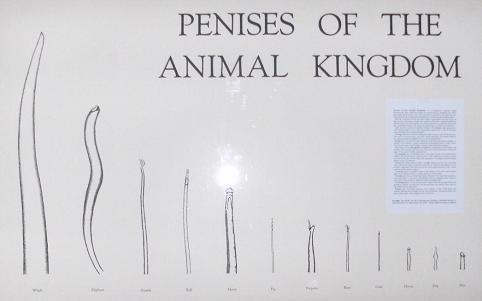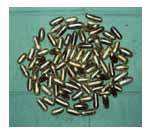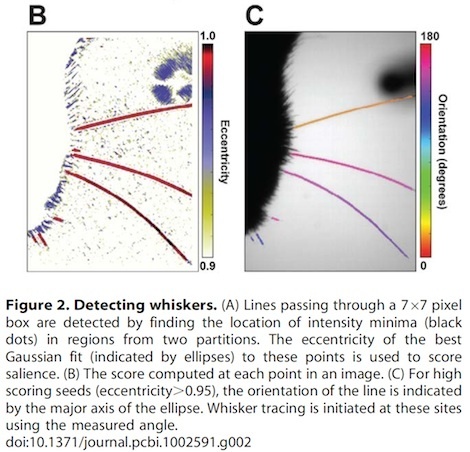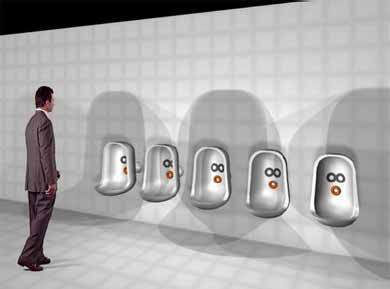Marc Abrahams's Blog, page 559
July 27, 2012
Whiskers-Tracking in Videos of Head Fixed Rodents
 This month’s Head Fixed Rodents Whisker-Tracking Study of the month is:
This month’s Head Fixed Rodents Whisker-Tracking Study of the month is:
“Automated Tracking of Whiskers in Videos of Head Fixed Rodents,” Nathan G. Clack [pictured, whiskered, here], Daniel H. O’Connor, Daniel Huber, Leopoldo Petreanu, Andrew Hires, Simon Peron, Karel Svoboda, Eugene W. Myers [pictured, whiskerless, here], PLoS Computational Biology, vol. 8, no. 7, 2012, e1002591. The authors, at Janelia Farm Research Campus, Howard Hughes Medical Institute, Ashburn, Virginia, report:
“We have developed software for fully automated tracking of vibrissae (whiskers) in high-speed videos (>500 Hz) of head-fixed, behaving rodents trimmed to a single row of whiskers.”
(Thanks to investigator Marcie Daley for bringing this to our attention.)
BONUS: Video of an earlier rat-whisker tracking attempt, performed elsewhere by others:

July 26, 2012
The Coriolis effect, trouser leg preference, and human rotation
Theoretical and practical investigations have shown that the ‘Coriolis effect’ (see video above) can substantially influence physical systems such as the trajectory of cannon balls and the rotation of meteorological phenomena. But very little research has addressed the issue of whether it might also affect human behaviour. For example, might the Coriolis effect affect which direction you stir liquids in a pot or cup? Or which way you prefer to rotate (figure skater style)?
By way of an online survey, a research team from the University of Cambridge department of psychiatry (Dr. Jan Stochl, Research Associate, and Dr. Tim Croudace, Senior Lecturer) asked questions of 1526 respondents in 97 countries – questions such as :
• “Imagine someone calls at you directly behind your back. Which direction do you prefer to turn around?”
• “Which direction do you stir liquids in a pot or cup?”
• “Try or imagine you jump and spin around at the same time (like figure skaters do). Which direction would you rotate?”
• “Which leg do you put in your trousers first when you are getting dressed/clothed?”
Crucially, the survey also requested information about the physical location(s) of the respondents. Thus the researchers were able to classify them in as either in the Northern or Southern hemispheres (where the Coriolis effect has opposite effects). Analysis of the results revealed (possibly for the first time) that :
“Geospatial location does not predict the preferred direction of rotation [...] and excludes the Coriolis effect as a predictor of rotation.”
The team’s paper ‘Predictors of human rotation’ is scheduled for future publication in the scholarly journal Laterality.

Penises of the Animal Kingdom poster
A look back at the winner of the 1992 Ig Nobel Prize in Art, awarded jointly to Jim Knowlton, modern Renaissance man, for his classic anatomy poster “Penises of the Animal Kingdom,” and to the U.S. National Endowment for the Arts for encouraging Mr. Knowlton to extend his work in the form of a pop-up book:

[The following description, written by Mr. Knowlton, accompanies each copy of his poster]
Penises shown on the poster, left to right: Whale, Elephant, Giraffe, Bull, Horse, Pig, Porpoise, Ram, Goat, Hyena, Dog, Man.
Informative flyer: “Penises of the Animal Kingdom” is a comparative anatomy chart featuring the male copulatory organs of several animals, including man. Each illustration was rendered with close attention to proportion and scale, the size determined by the average physical dimensions of the genitalia of adult males.
With the exception of man, the entire organ is represented, from tip to base. In other words, each figure includes the segment of the penis contained within the animal’s body. For most species, the internal portion is a significant fraction of the overall penis length. All organs are depicted erect at twenty percent actual size.
Each penis has certain outstanding features. The human organ possesses a well-defined glans, or tip. This mushroom-shaped end is one of the most evolved glandes of the animal kingdom.
The dog penis has a bulbous enlargement that is present only during erection. This bulb is the reason dogs “get stuck” while copulating. The female contracts her vagina around the trapped penis to extract seminal fluids.
Hyenas are well known for the similarity of the male and female genitalia. A female’s erect clitoris is nearly impossible to distinguish from a male’s penis. Covering the glans of each organ are sharp, backwardly-directed spines.
The penises of the ram, giraffe and goat have extensions of the urethra. The urethras of the giraffe and ram can extend up to four centimeters beyond the glans of the penis, forming a pliant hook.
The porpoise has a remarkable penis. The longer branch of its forked end is jointed, allowing the tip to rotate or swivel. The animal has voluntary control over this action and uses the finger-like appendage to manipulate and investigate objects in its environment.
Perhaps the oddest penis is that of the pig. During erection, the end of the penis convolutes into a corkscrew, bearing an uncanny resemblance to the animal’s coiled tail. The helical end of the erect organ conforms to the twisted contours of the female’s vagina.
The horse penis is similar to that of the human; it also has a well-defined glans. A dissimilar feature is a slight extension of the urethra.
The bull penis has an interesting history. Because of it rope-like consistency and proportions, it was used in the Middle Ages as a flogging stick. Today, in some parts of the world, it is dried and used as a walking cane.
The elephant has a very muscular penis. Half of the curved organ forms the pendulous portion, yet only the very end penetrates the hard-to-reach vulva of the female during copulation.
Whales have the largest penises of all animals. A blue whale penis can measure thirteen feet in length and one foot in diameter. The poster depicts the sperm whale penis with a length of over seven feet.
BONUS: BASIC HUMAN ANATOMY A215 — A course at Indiana University, featuring instructor Jim Knowlton.
BONUS: GROSS HUMAN ANATOMY A550-A551 — A course at Indiana University, featuring instructor Jim Knowlton.

July 25, 2012
Probably a typo: Bum Center
The title of this medical study probably contains a typographical error:
“Enterobacter cloacae Septicemia in a Bum Center: Epidemiology and Control of an Outbreak,” C. Glen Mayhall, V. Archer Lamb, William E. Gayle Jr. and Boyd W. Haynes Jr,, Journal of Infectious Diseases, Volume 139, Issue 2, 1979, pp. 166-171.

Aesthetic judgement of paintings hung wrong-way-up
 It’s alleged that even the most prestigious art galleries sometimes hang artist’s work the wrong way up. But very little scientific research has addressed the issue of whether the public-at-large can correctly guess whether a modern art painting is the right way up or not. Prompting George Mather, who is Professor of Vision Science, School of Psychology, University of Lincoln and Visiting Professor of Psychology, School of Psychology, University of Sussex, UK, to perform an experimental study to help find out.
It’s alleged that even the most prestigious art galleries sometimes hang artist’s work the wrong way up. But very little scientific research has addressed the issue of whether the public-at-large can correctly guess whether a modern art painting is the right way up or not. Prompting George Mather, who is Professor of Vision Science, School of Psychology, University of Lincoln and Visiting Professor of Psychology, School of Psychology, University of Sussex, UK, to perform an experimental study to help find out.
Eighteen naïve participants (students) none of whom had any previous formal training in art, judged forty modern artworks in randomly presented orientations (0, 90, 180 or 270 degrees). The results are revealed in “Aesthetic judgement of orientation in modern art” which is published in i-Perception, vol. 3, no. 1, 2012, pp. 18–24. The study found that participants’ judgement of the ‘correct’ - i.e. the artist’s preferred orientation – depends to some extent on the perceived ‘Meaningfulness’ content of the artwork. So, for example, Fernand Leger’s Two Women with Still Life was correctly guessed 88.89% of the time. Whereas Kasimir Malevich’s – Suprematist Composition: Airplane Flying scored a disappointing 0%.
Puzzlingly, however, some paintings, which appeared to have very little ‘meaningful’ content (e.g. Jackson Pollock’s One: Number 31) were fairly consistently orientated correctly. “The origin of these orientation judgements remains to be identified. “ says the professor.
The full list of paintings used in the study is here.
Note: The artwork above was created using the online Pollock Generator at jacksonpollock.org.

July mini-AIR: “Biosorption and Me”, etc.
 The July issue of mini-AIR just went out. Topics include:
The July issue of mini-AIR just went out. Topics include:
“Biosorption and Me”
Human Cow-Output Dependence
and more
It also has this winning entry (by INVESTIGATOR NEIL GREENBERG) for last month’s competition. which asked for a limerick to honor the study “Experience With the Use of a Defoaming Agent in The Treatment of Gastrointestinal Gas“:
Ingesting of high-fiber grass
Makes gastrointestinal gas
So keep in your home
A can of defoam
And insert it…where? Gullet or ass?
Mel [pictured here] says, “It’s swell.” (mini-AIR is the simplest way to keep informed about Improbable and Ig Nobel news and events. Just add yourself to the mini-AIR list, and mini-AIR will be emailed to you every month)

July 24, 2012
The German physicians’ ‘Body packer’ conundrum
 If you were, say, a German surgeon performing an operation to remove illicit drugs from the body cavity of a ‘body packer’, what would be your options for disposing of the drugs – without breaking the law or transgressing ethical boundaries?
If you were, say, a German surgeon performing an operation to remove illicit drugs from the body cavity of a ‘body packer’, what would be your options for disposing of the drugs – without breaking the law or transgressing ethical boundaries?
Just such a conundrum is described in a 2004 article for the German medical journal Der Chirurg. „Bodypacker“ als chirurgischer Notfall Wem gehört das Rauschgift?, where M. Wittau, D. Weber, B. Reher, K.H. Link, D. Henne-Bruns and M. Siech explain the following predicament.
“Even though the body packer remains the legal owner of the drugs, physicians may not return the drugs, since that constitutes the criminal offence of dealing in narcotics.”
But, to complicate matters further :
”Returning the drugs to law enforcement authorities is also prohibited because of professional medical discretion.”
In that case, there is, according to the authors, only one viable option :
“The only way out of this predicament is for physicians to destroy the drugs under the observation of witnesses.”
The title in English is: Emergent [sic] surgery for body packing — what happens to the drugs? Der Chirurg, Volume 75, Number 4 (2004), pp. 436-441

Ig Nobel Tickets will go on sale AUGUST 1
Tickets for the Twenty-Second 1st Annual Ig Nobel Prize Ceremony will go on sale WEDNESDAY, AUGUST 1, 2012, at noon (US eastern time).

ALL the tickets will go on sale at once. We expect that this year’s tickets will (as usual) get snapped up very quickly.
The Harvard Box Office handles all ticket sales.
Tickets in Person: The physical ticket office, in Holyoke Center, is open some (but not all!) days from noon to 6 pm.
Tickets Online: The Harvard Box Office web site is open 24 hours, every day.
Tickets by telephone: (+1) 617-496-2222.
THE CEREMONY
The ceremony will happen at the usual place:
WHERE: Sanders Theatre, Harvard University.
WHEN: THURSDAY, SEPTEMBER 20, 2012, 7:30 pm.
This year’s theme: THE UNIVERSE.
BONUS: Join our private email list to receive (very occasional) reminders about upcoming Ig Nobel and Improbable Research events.

July 23, 2012
Study: Why my baby is less disgusting than yours
When a mother compares and contrasts the stench from her baby’s nappies with that from those of someone else’s baby, the question of disgust arises. The question drove a team of psychologists to do an experiment. Richard Stevenson and Trevor Case, of Macquarie University in Sydney, Australia, and Betty Repacholi of the University of Washington in Seattle issued a report called My Baby Doesn’t Smell As Bad As Yours – The Plasticity of Disgust. It appeared in a 2006 issue of the journal Evolution and Human Behavior.
Stevenson, Case, and Repacholi present their work as an addition to a body of earlier smelly investigation….
So begins this week’s Improbable Research column in The Guardian.

July 22, 2012
Black humour meets product design, in Taiwan
● “A rascal wanted to rob, but he carelessly treaded on banana skin. Finally, he was dead by killing himself.”
This ‘black humor’ joke features in Yun Tu’s 2006 Thesis for Master of Science at the Department of Industrial Design, of Tatung University, Taiwan. The subject under investigation was ‘Contrast Images on Products with Black Humor’. Yun examined how the concept of ‘black humor’ might be applied to industrial design projects.To set the scene, here are some more examples of ‘black humor’ jokes from the thesis :
● Someone’s feet are stinky, but he smells them before me and
says, “Not at all! Their smells are good. Do you want to smell?”
● I am 70 km. My husband often says, “Honey, how much does
your leg sell?” or “Honey, you have already put on your life
ring.”
● After a thief was arrested, the police asked, “Do you steal something?” The thief answered, “No, I just take what I want and forget to pay out.”
● Disrobe and run happily when there is snow.
With such jokes in mind, the author used computer assisted design (CAD) techniques to create virtual mock-ups of concept products which featured varying degrees of black humor. Examples included :
● the Nipple Power Source Switch, (pictured above)
● the Idiot Coffemaker,
● the ‘Stabbing You to Death’ desk lamp,
● Mr. Fuck’s Nut Cracker
● and the Elephant Urinal (pictured below).
A group sample of potential users then evaluated each of the black humor based designs – with mixed reactions. Leading to a batch of conclusions which are too complex to succinctly summarise here. But those interested in the possible links between black humor and product design have the chance to evaluate their pros and cons by reading the full thesis, which is available online. (scroll to page 98 for the English version. Note : slow 4.8 MB download)

Marc Abrahams's Blog
- Marc Abrahams's profile
- 14 followers


























